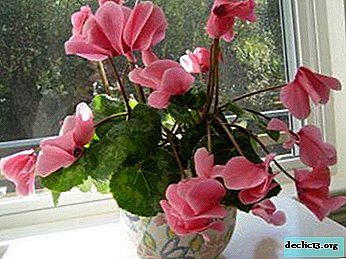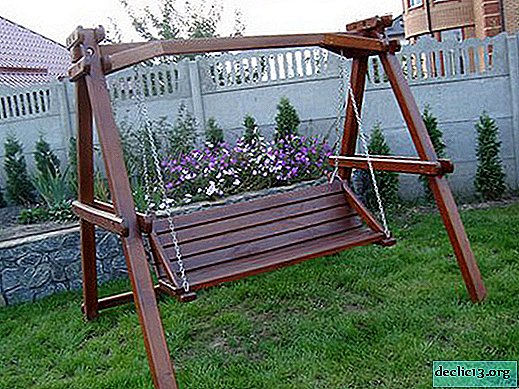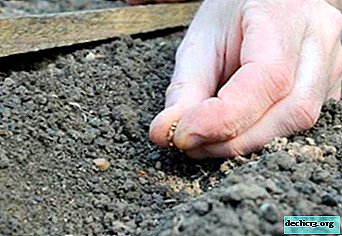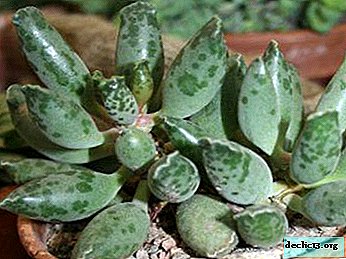Basic rules for trimming Kalanchoe

Kalanchoe is a beautiful plant native to Madagascar, characterized by a large species diversity (the most common - Blosfelda and Kalandiva) and, accordingly, a variety of colors. In addition, Kalanchoe is very much appreciated by amateur gardeners for healing properties (for example, the juice of this plant helps with a runny nose).
Like all plants, Kalanchoe has its own characteristics and care rules, which must be taken into account so that it continues to please with its colors.
Plant features
In general, the plant is quite unpretentious, it is not very difficult to care for it, so it is well suited to buy it as a gift. At home, Kalanchoe, as a rule, does not grow more than half a meter in height. How to care for Kalanchoe so that it blooms can be found here.
The plant tolerates a short period of drought quite easily.but excessive watering is dangerous for him. When watering, it is worthwhile to ensure that the soil is wetted to the full depth, but there should not be excess moisture. It is worth choosing a frequency of watering so that the soil has time to dry. In summer, watering should be frequent, in winter - once every two weeks.
Reference! Kalanchoe loves bright light, and in winter she needs an additional light source. It is better to keep Kalanchoe in a temperature not higher than +25 and not lower than +12 degrees, and in the heat of Kalanchoe it is necessary to water daily.In winter, it is important to prevent moisture from entering the leaves. At the same time, in the summer you need to wipe the leaves in order to clean them from dust and protect them from pests (what are the ways to treat Kalanchoe from diseases and pests?). Once a month, Kalanchoe must be fed with special fertilizer. An excess of fertilizer is detrimental to the plant! Also, the plant needs a frequent transplant (how to transplant Kalanchoe?).
What is this procedure?
“Pruning” refers to the removal of faded buds and excess leaves. Pruning is necessary to give the plant a beautiful shape, juiciness of the leaves and create favorable conditions for the life of the plant. As a result of pruning, the juice accumulated inside the Kalanchoe is more evenly distributed throughout the plant and the flower becomes resistant to drying and wilting.
The basic rules of its implementation
 Pruning rules vary by plant type:
Pruning rules vary by plant type:
- Kalanchoe Blossfeld, a plant blooming in red flowers, very calmly tolerate the pruning process.
- With other species (most often with plants that have white and yellow flowers) you need to be extremely careful: if you prune or remove too many leaves incorrectly, it will be detrimental to these species of Kalanchoe.
If you cut the stem during pruning, you should immediately sprinkle the cut with wood ash.
Advice! For trimming Kalanchoe, it is better to use scissors with a sharp blade to avoid unnecessary damage.How and when?
In winter (more precisely, after November), trimming Kalanchoe is categorically not recommended, since the plant is at rest. You can start in late spring, but at this time the plant can already bloom. You can not cut a flowering plant! If the Kalanchoe has bloomed, the procedure must be postponed until the end of flowering (how to care for flowering Kalanchoe?).
It is better to cut the plant in the morning (before lunch). After pruning, let the plant rest; it is not recommended to water it after the procedure.
There are several types of cropping:
- As soon as the plant comes to your house, you need to pinch it to form a crown and set the right direction of growth. To do this, remove two or three extreme leaflets on each branch. After this, new shoots will begin to grow.
Until you achieve the desired result, you should not allow contact of Kalanchoe with direct sunlight. Sunlight contributes to the rapid growth of the plant, and therefore the flower can stretch too much.
- From this moment on, it is necessary to periodically carry out preventive pruning to create a beautiful shape, and you need to do this until the desired result is achieved. It is not necessary to wait for the young shoots to grow. You can start pruning (pruning branches) and form a Kalanchoe as soon as new leaves appear.
Step-by-step instruction
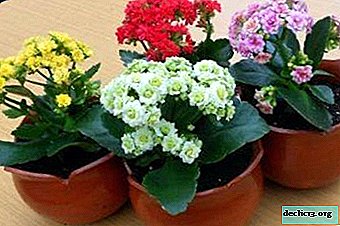 If the plant has grown and an ugly and weak tip has formed, remove it.
If the plant has grown and an ugly and weak tip has formed, remove it.- So that Kalanchoe grows in a thick "bush", carefully monitor the shoots. Remove the top two leaves from them as soon as they begin to grow.
- When two shoots appear in the place of the pinch, let them grow to the appearance of another pair of leaves and cut them at this level.
- Wait for another pair of shoots and a third pair of leaves to appear and repeat the procedure. If the bush has not yet acquired a beautiful rounded (or other shape you need), repeat the procedure until the desired result is achieved.
- The last time it is recommended to trim the Kalanchoe at the end of autumn (in November), preferably on a window on the south side of the house, or in winter on the east or west side of the house. Do not forget that in winter, Kalanchoe should be kept in a cool place (10-15 degrees).
How to do it after flowering?
Pruning Kalanchoe after flowering is also called cleansing pruning. Before you make a cleansing pruning, you must make sure that the plant has completely finished blooming.
- In this case, the leaves are trimmed in the same way as with prophylactic pruning: two or three extreme leaflets on the stems.
- After that, remove the flowered buds (peduncles). The buds are removed at the very bottom. It is necessary to remove every single flower stalk so that the plant does not begin to rot.
How to care in the future?
At the end of pruning, the plant should be allowed to rest. At this time, it is necessary to reduce watering and clean the plant away from direct sunlight, that is, not to keep it on the window at the most sunny time of the day, a table near the window is much better, especially if the window is curtained with a transparent tulle. The time for which the plant must fully recover after the pruning procedure is about a month (from 20 to 40 days).
So, if you follow all the rules (it is also advisable to consult with more experienced gardeners), you can grow a beautiful flower in your home and provide it with comfortable conditions for further propagation.

 If the plant has grown and an ugly and weak tip has formed, remove it.
If the plant has grown and an ugly and weak tip has formed, remove it.
